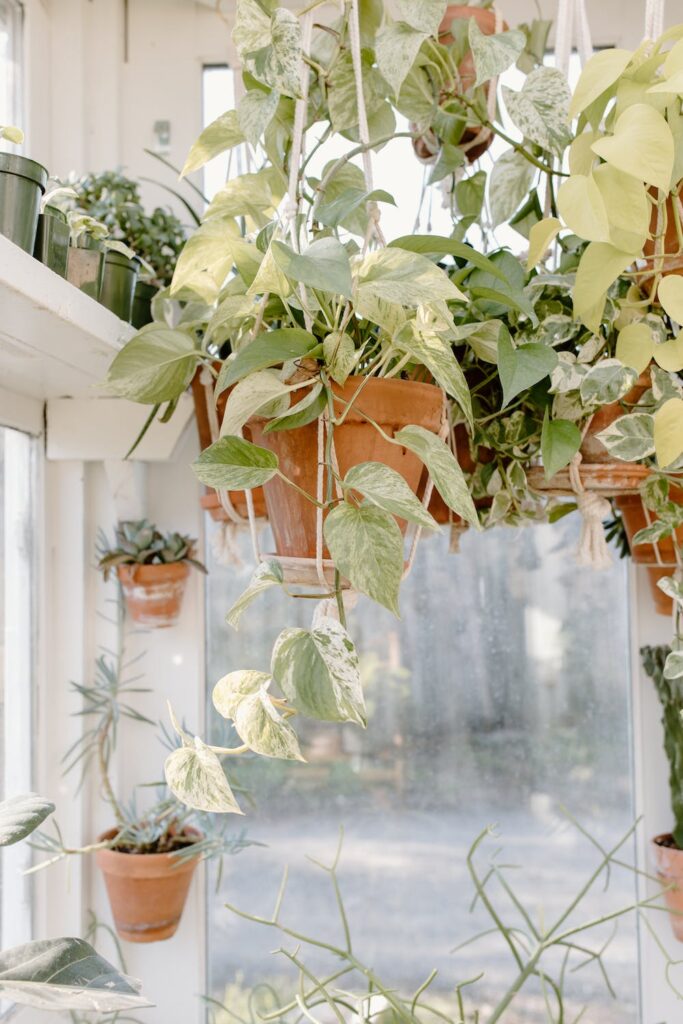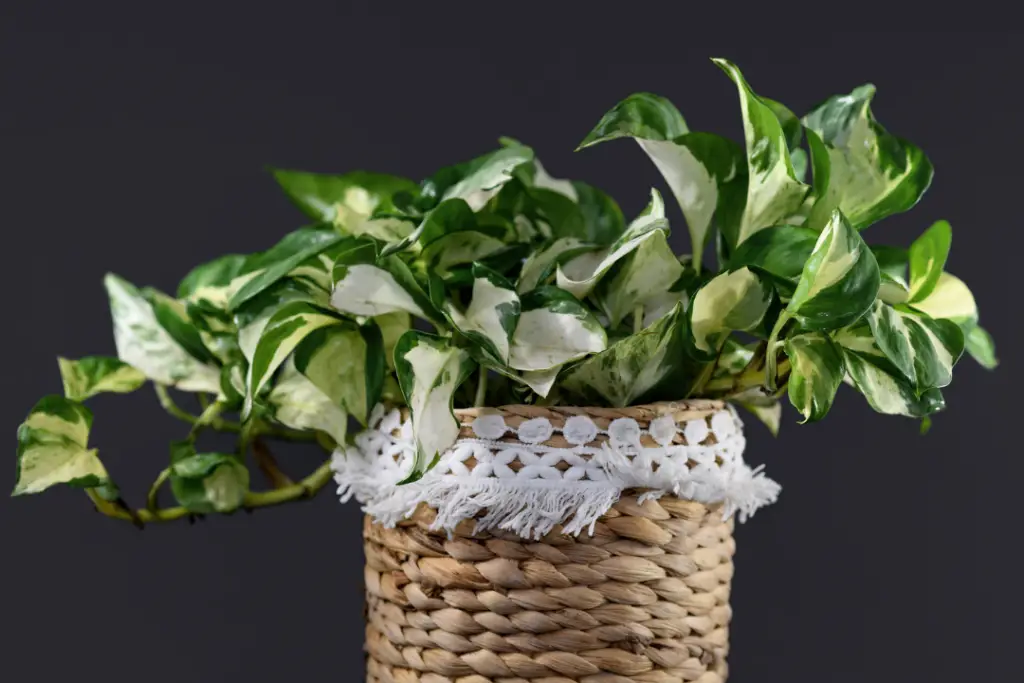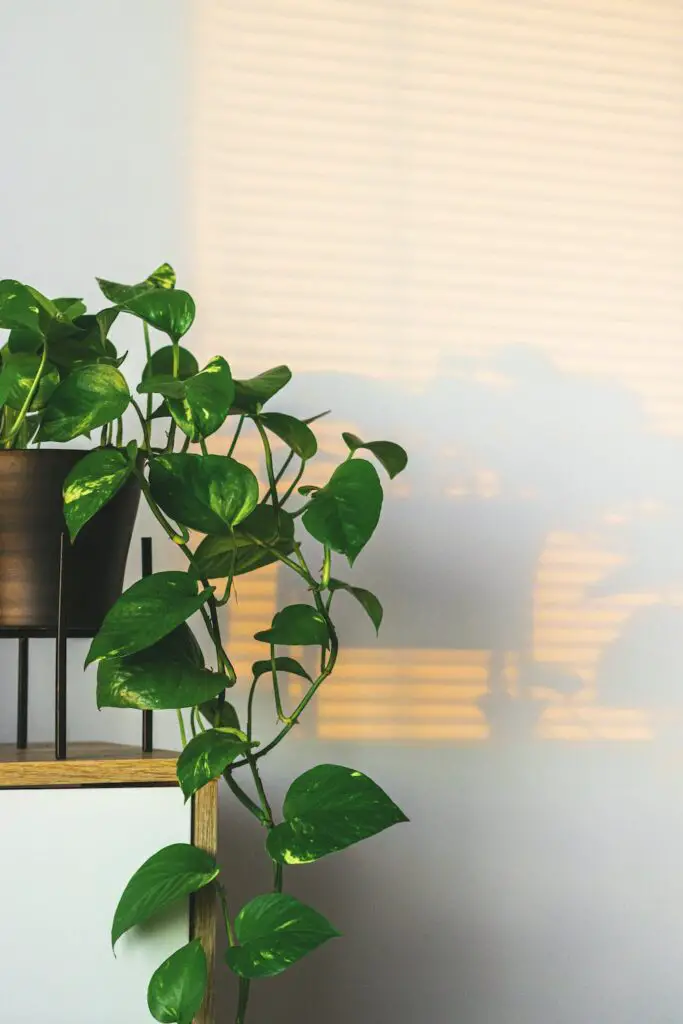Pothos, also known as Epipremnum aureum or devil’s ivy, is a popular houseplant that is loved for its attractive foliage and easy care. It is a trailing vine that can grow up to 10 feet long (3 meters) in its native habitat in Southeast Asia. Pothos has heart-shaped leaves that are typically variegated with green and yellow, but can also be solid green or golden. It is a hardy plant that can thrive in low-light conditions and doesn’t require frequent watering, making it a great choice for beginners and experienced plant parents alike. It is commonly grown as an indoor plant because it thrives in low-light conditions and doesn’t require frequent watering. In this article, we will discuss the basics of caring for a pothos plant.
Table of Contents
Variations of Pothos
Pothos is a popular and versatile houseplant that comes in a variety of different types and cultivars. Here are some of the most common types of pothos:
- Golden Pothos: This is the most common type of pothos, and it has green and yellow variegated leaves.
- Marble Queen Pothos: This pothos has white and green variegated leaves with a marbled appearance.
- Jade Pothos: This type of pothos has solid green leaves that are slightly smaller than other varieties.
- Neon Pothos: This pothos has bright, lime-green leaves that are a striking addition to any indoor space.
- Manjula Pothos: This cultivar has large, green leaves with creamy white edges and silver markings.
- Pearls and Jade Pothos: This cultivar has green and white variegated leaves with small, pearl-like spots throughout.



Care and maintenance
Each type of pothos has its own unique characteristics and growing requirements, so it’s important to choose the right one for your specific needs and environment. Regardless of the type, pothos is a low-maintenance and adaptable plant that can thrive in a wide range of indoor conditions.
Lighting requirements
Pothos thrives in low to bright indirect light, making it an excellent plant for almost any indoor space. However, it is essential to avoid direct sunlight as it can scorch the leaves. If you notice your pothos leaves turning yellow, it may be a sign that your plant is receiving too much direct light.
Watering requirements
Pothos is not a fan of constantly wet soil, so it is crucial to avoid overwatering. Allow the soil to dry out slightly between watering, and make sure the pot has proper drainage to prevent waterlogging. When watering your pothos, it’s best to water deeply, so the roots are well-watered. A good rule of thumb is to water your pothos once a week.
Temperature and Humidity requirements
Pothos is relatively tolerant of a wide range of temperatures. It can thrive in temperatures between 55°F to 85°F (12°C to 29°C) and can tolerate cooler temperatures. It is essential to avoid exposing it to temperatures below 50°F (10°C), as it can harm the plant. Pothos can also tolerate fluctuations in temperature, but sudden drops or spikes can cause stress on the plant. Keep your pothos in a temperature-controlled room away from drafts and extreme temperature changes to ensure that it stays healthy. Pothos prefers moderate to high humidity levels, but it can tolerate drier conditions. If you live in a dry climate, consider using a humidifier or placing a tray of water near your plant to increase humidity.
Soil and fertilisation requirements
Pothos prefers a well-draining, loose soil that is rich in organic matter. You can use a regular potting mix with added perlite or vermiculite to improve drainage. Pothos is a relatively low-maintenance plant, but it can benefit from occasional fertilisation. Use a balanced, water-soluble fertiliser once a month during the growing season to keep your pothos healthy and happy.
Pruning and Propagation
Pothos is a vine that can grow quite long, so regular pruning is essential to keep it looking neat and tidy. You can prune your pothos by cutting back the vines to the desired length or removing any yellowing or damaged leaves. Pothos is a straightforward plant to propagate. You can propagate your pothos by taking stem cuttings and rooting them in water or soil. Simply cut a few inches of vine with a few leaves, remove the lower leaves, and place the stem in water or soil. Keep the cutting moist, and within a few weeks, it should start to grow roots and new leaves.
Repotting a Pothos
Repotting a pothos is usually only necessary every 1-2 years as it grows relatively slowly. When repotting, it is essential to choose a pot that is only slightly larger than the current one to prevent the plant from becoming waterlogged. It’s also important to use a well-draining soil mix that is rich in organic matter. To repot, gently remove the plant from its current pot and loosen the roots. Add some fresh soil to the bottom of the new pot, place the plant in the center, and fill in with additional soil. Water the plant thoroughly and place it in a location with the appropriate light and temperature requirements. After repotting, it’s best to avoid fertilising for a few weeks to allow the plant to adjust to its new home.


Pest control
Pothos is generally a pest-resistant plant, but it can occasionally attract pests such as spider mites, mealybugs, and scale insects. If you notice signs of an infestation, such as yellowing or stippling on the leaves, it’s best to isolate the plant to prevent the pests from spreading to other plants. You can try to remove the pests manually with a cotton swab dipped in rubbing alcohol or by washing the plant with a gentle soap solution. For more severe infestations, you may need to use an insecticidal soap or neem oil spray, following the instructions carefully. Remember to monitor your plant regularly to catch any potential pest problems early and prevent them from spreading.
Conclusion
In conclusion, pothos is an excellent houseplant for beginners and experienced plant parents alike. With the right care, your pothos plant can thrive and add a touch of greenery to your home or office. Remember to provide your pothos with adequate light, water, and nutrients, and your plant will reward you with lush growth and beautiful foliage.


How To Troubleshoot Common Devil's Ivy Plant Problems | Oxygen Land
Saturday 15th of June 2024
[…] Devil’s ivy is generally easy to care for, but some tips can help maintain its health: […]